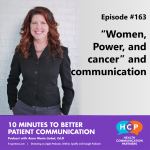I look at a recent report from a Lancet Commission on Women, Power, and cancer, and consider where communication comes into it. I finish with something you can do if you’re thinking about power in your communication.

Today’s episode is about communication and power. We’re looking at a recent report from a Lancet Commission on Women, Power, and cancer. And I’ll finish with something you can do if you’re thinking about power in your communication. Hi everybody, this is 10 Minutes To Better Patient Communication From Health Communication Partners. I’m Dr. Anne Marie Liebel. If you’re responsible for quality improvement, patient experience, or patient education, you’ll like our course Equitable Patient Education. Because it’s quick, it’s convenient, it’s accessible, ready to go, and the pricing is great. Ticks all the boxes, and I made it for you. For more information visit healthcommunicationpartners.com or find me on linked.
I want to say hi because we’ve got some new listeners! We’ve had more of those days where we’ll get over a thousand downloads in a day, like today and yesterday! This is super exciting, because as you might know, it was our 6th anniversary last month. And a lot of shows plateau, and we’re not! So after 6 years of doing this, having new listeners and seeing the community keep growing is amazing to me. If you want to say happy birthday, you know what I would love as a birthday gift? A review! Let us know how you’re thinking about the show on whatever platform you’re listening.
Alright, so the Lancet. Recently the Lancet published a report of a commission that was created to investigate the intersection of women power and cancer. And I learned about this on social media, and the title grabbed me: Women, power, and cancer: A lancet commission. And you know if you’ve listened to the show for a minute that it’s about communication. So I am going to get down to what communication has got to do with women and power and cancer, because it’s quite a lot.
I’m glad people are talking about power. I’m not sure that we do it enough. There’s a lot of ways that power relates to language. Just speaking is an exercise of power, right? You’ve heard phrases like, you know use your voice or make your voice heard as meaning you use your personal power. And we, when we speak, we are using our power to make things happen or try to keep them from happening.
More subtly, maybe unintentionally sometimes, we can keep people away with our words. Or send signals like no, this is not for you. We can be exclusive. We can limit people’s chances to participate. We don’t want that. We want inclusion. We want shared decision making. We want co-creation. Which is why, when we think about communication, we also have to think about power.
I’ve talked about power and communication explicitly in the show before. But it’s always a concern on the show, even when it’s not the topic. Because the research base I come from in communication sees power as Central to communication, always a part of it. But our guests talk about it, too. And I want to share two past interview episodes where the guests explicitly talk about power and communication. One from the clinicians’ point of view, with Dr. Jonas Attilus. And then one about public health programs, with Dr. Renata Schiavo. So I’ll put those links in the show notes.
Now I’m going to return to this Lancet report, so you can see what I mean about the connections between power and language. Because even though that’s not what the report is really about, communication is there, so I’m going to draw our attention to it. One of these times is the implication that communication is one of the ways that power Works, in this case negatively, toward patients. And it’s through stigmatization and discrimination of patients by the health system. The report finds that, “fear and experience of stigmatization, and discrimination by the health system, all of which can impede their timely access to diagnosis, treatment, and quality cancer care.”
We’ll unpack that for a second. We all know, from being alive, that stigmatization and discrimination happen in part through language. So this finding here from the commission shows us images of people in power—the health system–using the power of their words on others. Intentionally or not, the result of this exercise of power is impeding timely access to care. So that’s a negative show of power.
Here’s another way power works through language, again negatively. This is about women in the cancer workforce, and bullying and sexual harassment. “Women in the cancer workforce, as in other disciplines, report frequent and severe experiences of gender-based discrimination, including bullying and sexual harassment, both during their medical and residency training and at the workplace. These harassment practices are usually perpetrated by male superiors and colleagues, although also by male patients and patients’ relatives, and have been reported to negatively affect women’s mental health, perception of workplace safety, job satisfaction, and career development.”
Again here we have a finding of people using the power of their words. Bullying and sexual harassment we know happen in part through language. So we’ve got people using the power of their words on others. Here there’s a suggestion it’s intentionally to do harm. And this exercise of power does do harm to mental health, perceptions of safety, job satisfaction, and career development.
Beyond individual level actions, the commission shows how language is allied to power at an Institutional level through culture. They say, “These unacceptable and highly prevalent practices persist due to a hierarchical, male-dominated culture that accepts abusive behaviour as part of medical training and workplace socialisation, and avoids holding offenders accountable.”
We’re at an Institutional level here. It’s the culture, these repeated, historical sets of practices–in this case, medical training and workplace socialization. And again, many of these practices include language use. That is, a lot of this happens through language, including ways of talking and relating to other people through language.
The Lancet report recommends 10 priority actions, and I think these actions are doable, they’re straightforward, I daresay some are kind of common sense, like why are we not doing these already?! And communication crosses several of them. So of course I’m going to put the link in the show notes so you can see them for yourselves. They also propose a set of gender competencies and communication is part of them as well.
Maybe your communication is not so full of the egregious examples that the commission found. If you’re thinking about the subtler ways language can include or exclude, and you want something you can do right now, I’ve got you covered.
First of all, yay! Keep being curious about your language. Let yourself be a student of your own conversations with patients or clients or colleagues. Even just for a day. You can do that by picking one piece of your everyday conversations to focus on. I’d suggest one that’s easy to notice, like how you open a conversation, or how you close a conversation. Questions are also easy to spot and generally memorable. I’m going to suggest that you, even just for one day, jot them down. Record them if you can, but jot them down right after a conversation. What did you actually say? As close as you can get to what you remember. And look at them.
When you look at what you’ve jotted down, I’m going to ask you to think of these questions:
- What kind of room are you making for other people? How are you including them?
- How are you including their knowledge?
- How are you including their questions?
Now if you like what you’re hearing, I’ve got good news for you: we’ve got a whole course on Equitable Communication. Visit HealthCommunicationPartners.com and click on Courses.
This has been “10 Minutes to Better Patient Communication” from Health Communication Partners. Audio engineering and music by Joe Liebel. Additional music by Alexis Rounds.

